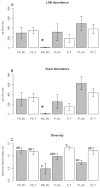Physical, Chemical, and Microbiological Characteristics of Pulque: Management of a Fermented Beverage in Michoacán, Mexico
- PMID: 32244861
- PMCID: PMC7143500
- DOI: 10.3390/foods9030361
Physical, Chemical, and Microbiological Characteristics of Pulque: Management of a Fermented Beverage in Michoacán, Mexico
Abstract
Pulque is a beverage that has been prepared in Mexico since pre-Hispanic times from the fermented sap of more than 30 species of wild and domesticated agaves. We conducted studies in two communities of the state of Michoacán, in central-western Mexico, where we documented its traditional preparation and analyzed the relationship between preparation conditions and the composition and dynamics of microbiological communities, as well as the physical and chemical characteristics of the beverage. In one of the communities, Santiago Undameo (SU), people boil the sap before inoculating it with pulque inoculum; this action causes this local pulque to be sweeter, less acidic, and poorer in bacteria and yeast diversity than in the other community, Tarimbaro (T), where the agave sap is not boiled and where the pulque has more diversity of microorganisms than in SU. Fermentation management, particularly boiling of the agave sap, influences the dynamics and diversity of microbial communities in the beverage.
Keywords: agave sap; biocultural diversity; probiotics; traditional knowledge.
Conflict of interest statement
The authors declare no potential conflicts of interest with respect to the research, authorship, and publication of this article.
Figures



Similar articles
-
Management, morphological and genetic diversity of domesticated agaves in Michoacán, México.J Ethnobiol Ethnomed. 2020 Jan 16;16(1):3. doi: 10.1186/s13002-020-0353-9. J Ethnobiol Ethnomed. 2020. PMID: 31948439 Free PMC article.
-
Pulque, a Traditional Mexican Alcoholic Fermented Beverage: Historical, Microbiological, and Technical Aspects.Front Microbiol. 2016 Jun 30;7:1026. doi: 10.3389/fmicb.2016.01026. eCollection 2016. Front Microbiol. 2016. PMID: 27446061 Free PMC article. Review.
-
Traditional management of microorganisms in fermented beverages from cactus fruits in Mexico: an ethnobiological approach.J Ethnobiol Ethnomed. 2020 Jan 10;16(1):1. doi: 10.1186/s13002-019-0351-y. J Ethnobiol Ethnomed. 2020. PMID: 31924218 Free PMC article.
-
Deep microbial community profiling along the fermentation process of pulque, a biocultural resource of Mexico.Microbiol Res. 2020 Dec;241:126593. doi: 10.1016/j.micres.2020.126593. Epub 2020 Sep 20. Microbiol Res. 2020. PMID: 33045640
-
Mezcal: A Review of Chemistry, Processing, and Potential Health Benefits.Foods. 2025 Apr 18;14(8):1408. doi: 10.3390/foods14081408. Foods. 2025. PMID: 40282809 Free PMC article. Review.
Cited by
-
Traditional Fermented Beverages of Mexico: A Biocultural Unseen Foodscape.Foods. 2021 Oct 9;10(10):2390. doi: 10.3390/foods10102390. Foods. 2021. PMID: 34681439 Free PMC article. Review.
-
Disaccharides and Fructooligosaccharides (FOS) Production by Wild Yeasts Isolated from Agave.Foods. 2025 Aug 1;14(15):2714. doi: 10.3390/foods14152714. Foods. 2025. PMID: 40807650 Free PMC article.
-
Aguamiel, a Traditional Mexican Beverage: A Review of Its Nutritional Composition, Health Effects and Conservation.Foods. 2025 Jan 6;14(1):134. doi: 10.3390/foods14010134. Foods. 2025. PMID: 39796424 Free PMC article. Review.
-
Thriving in Adversity: Yeasts in the Agave Fermentation Environment.Yeast. 2025 Jan;42(1-3):16-30. doi: 10.1002/yea.3989. Epub 2025 Feb 19. Yeast. 2025. PMID: 39967574 Free PMC article. Review.
References
Grants and funding
LinkOut - more resources
Full Text Sources
Miscellaneous

